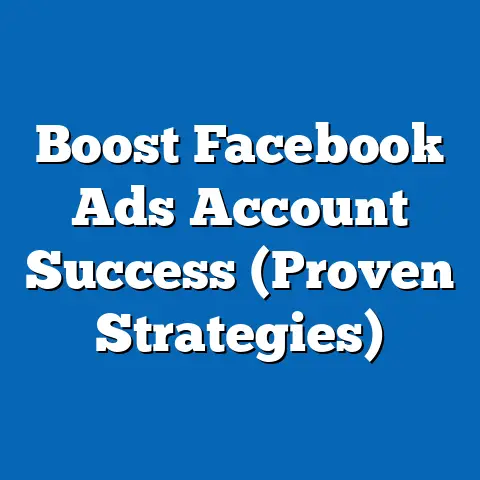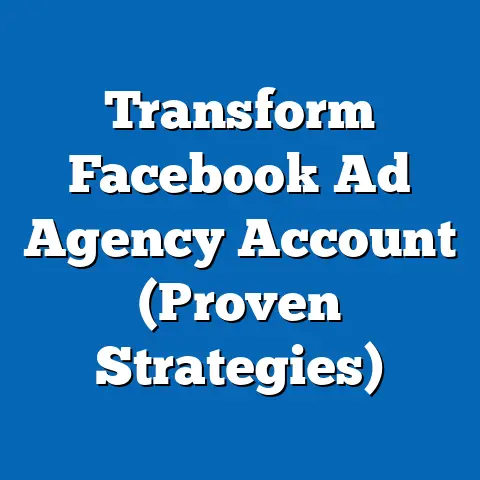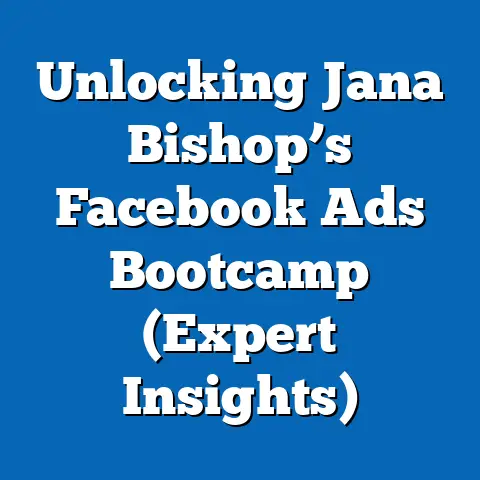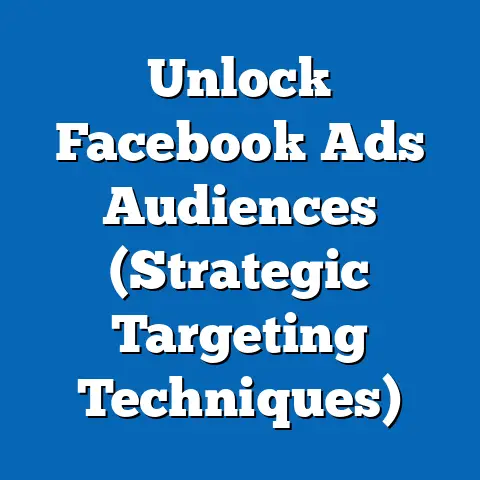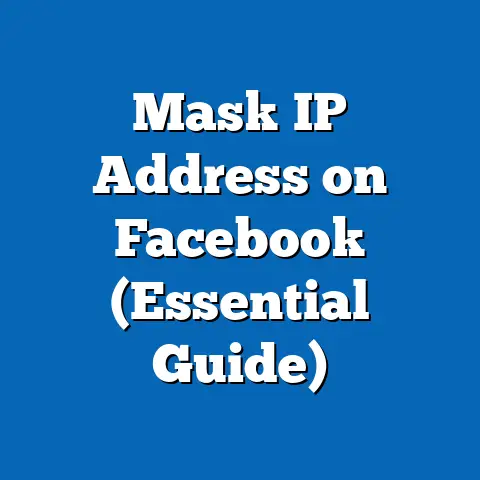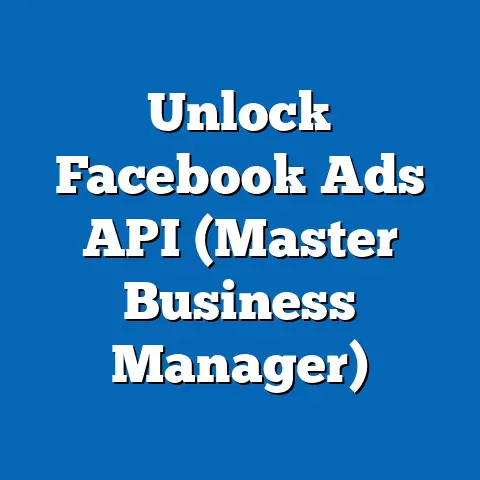Reconnect Facebook Ads & Instagram (Unlock Hidden Potential)
I remember when I first started in digital marketing, Facebook was the undisputed king of social media advertising. Instagram was this cool, visual platform that seemed almost separate. I treated them as distinct entities in my marketing strategy. It was like having two different tools in my shed, not realizing they could work together to build something amazing.
Then, something shifted. I saw a young entrepreneur, let’s call her Sarah, who ran a boutique clothing brand. Sarah was a trendsetter. She didn’t just see Facebook and Instagram as separate entities; she saw them as two sides of the same coin, a unified force for reaching her target audience. She understood the power of a cohesive, integrated strategy and she was determined to make it work.
Sarah’s journey wasn’t without its challenges. She struggled with aligning her brand messaging, finding the right ad formats, and tracking performance across both platforms. But she persevered, experimenting with different approaches and learning from her mistakes. Eventually, she cracked the code.
Sarah’s story is a testament to the hidden potential that lies within reconnecting Facebook Ads and Instagram. It’s about building a unified brand presence, leveraging shared data, and creating a cohesive customer journey. It’s about understanding that these platforms, when working together, can be far more powerful than the sum of their parts. I’ve since adopted this principle and seen incredible results, and I’m here to share how you can do the same.
Understanding the Synergy Between Facebook Ads and Instagram
The first step in unlocking the hidden potential of reconnecting Facebook Ads and Instagram is to understand the inherent synergy between these two platforms. They are, after all, owned by the same company, Meta, and designed to work together seamlessly.
Think of Facebook as the workhorse, providing robust targeting options, detailed analytics, and a wide range of ad formats. It’s the platform where you can really dig deep and fine-tune your audience based on demographics, interests, behaviors, and more.
Instagram, on the other hand, is the storyteller. It’s a visually driven platform where you can capture attention with stunning images and engaging videos. It’s where you can build brand personality and connect with your audience on a more emotional level.
When these two platforms work together, you get the best of both worlds. You can use Facebook’s targeting capabilities to reach the right audience, and then use Instagram’s visual appeal to capture their attention and drive engagement.
Consider these key statistics:
- Over 2 billion people can be reached with ads on Instagram. This is a massive audience, and it’s constantly growing.
- Instagram’s ad revenue is a significant portion of Meta’s overall ad revenue. This shows that businesses are increasingly recognizing the value of advertising on Instagram.
- Visual content is more likely to be shared and remembered. This is where Instagram shines. Its focus on visuals makes it perfect for creating memorable and engaging ad experiences.
The interconnected features between Facebook and Instagram are also crucial. You can use the same ad account to manage campaigns on both platforms, create custom audiences based on user behavior on both Facebook and Instagram, and track performance across both platforms in a single dashboard.
Takeaway: Facebook and Instagram are not competitors; they are complementary platforms. By understanding their individual strengths and how they can work together, you can create a more effective and impactful advertising strategy.
Historical Context of Facebook Ads and Instagram Marketing
To fully appreciate the potential of reconnecting Facebook Ads and Instagram, it’s helpful to understand the historical context of advertising on these platforms.
Facebook Ads has been around for quite some time, evolving from simple banner ads to the sophisticated, data-driven advertising platform we know today. It has gone through multiple iterations, each one bringing new features and capabilities.
Instagram, on the other hand, was initially a purely organic platform. But after being acquired by Facebook in 2012, it gradually introduced advertising features. The rise of Instagram as a marketing powerhouse was a game-changer. Its visual-centric approach and highly engaged user base made it a prime target for brands.
One of the most significant milestones was the introduction of Instagram Stories ads. This ad format allowed brands to reach users in a more immersive and engaging way, capturing their attention with full-screen visuals and interactive elements. The introduction of Reels ads further cemented Instagram’s position as a leading advertising platform.
Over the years, brands have successfully adapted their strategies to utilize both platforms effectively. They’ve learned to create cohesive campaigns that span across Facebook and Instagram, leveraging the strengths of each platform to achieve their marketing goals.
I remember one campaign I ran for a local restaurant. We used Facebook Ads to target people who were interested in food and dining, and then used Instagram Stories ads to showcase mouthwatering photos and videos of their dishes. The results were phenomenal. We saw a significant increase in reservations and foot traffic.
Takeaway: Understanding the historical context of advertising on Facebook and Instagram can help you appreciate the evolution of these platforms and the strategies that have proven to be successful over time.
Identifying the Hidden Potential of Reconnection
Now, let’s delve into the specific features and tools that marketers can harness to unlock the full potential of reconnecting Facebook Ads and Instagram.
One of the biggest advantages is the ability to create a unified brand presence across both platforms. This means ensuring that your brand messaging, visuals, and overall tone are consistent across Facebook and Instagram. When users see your ads on both platforms, they should immediately recognize your brand and understand what you stand for.
This unified brand presence can lead to improved brand recognition and customer loyalty. When users see your brand consistently across multiple touchpoints, they are more likely to remember it and develop a positive association with it.
Another key benefit is the ability to leverage shared data and audience insights. Facebook and Instagram share a wealth of data about their users, including their demographics, interests, behaviors, and more. By connecting your ad accounts, you can access this data and use it to create more targeted and effective advertising campaigns.
For example, you can create custom audiences based on user behavior on both Facebook and Instagram. You can target people who have visited your website, engaged with your content, or made a purchase in the past. This allows you to reach the most relevant audience with your ads and increase your chances of driving conversions.
I once worked with an e-commerce client who was struggling to generate sales on Instagram. After connecting their Facebook Ads account, we were able to create a custom audience of people who had abandoned their shopping carts on their website. We then targeted these users with Instagram ads featuring the products they had left behind. The results were incredible. We saw a significant increase in sales and a reduction in cart abandonment rates.
Takeaway: Reconnecting Facebook Ads and Instagram allows you to create a unified brand presence, leverage shared data, and create more targeted and effective advertising campaigns.
Real-World Case Studies
To illustrate the potential of reconnecting Facebook Ads and Instagram, let’s take a look at some real-world case studies.
Case Study 1: Fashion Brand
A fashion brand wanted to increase its brand awareness and drive sales among young adults. They created a cohesive campaign that spanned across Facebook and Instagram. On Facebook, they used carousel ads to showcase their latest collections, targeting users based on their interests in fashion and shopping. On Instagram, they used Stories ads to feature behind-the-scenes content, influencer collaborations, and user-generated content.
The results were impressive. They saw a significant increase in brand awareness, website traffic, and sales. They also saw a boost in engagement on both platforms, with users liking, commenting, and sharing their content.
Case Study 2: Technology Company
A technology company wanted to generate leads for their new software product. They used Facebook Ads to target business professionals based on their job titles, industries, and interests. On Instagram, they used video ads to demonstrate the features and benefits of their software. They also used Instagram Stories ads to run polls and quizzes, engaging users and generating leads.
The results were outstanding. They saw a significant increase in leads, website traffic, and demo requests. They also saw a boost in brand credibility, with users perceiving them as a thought leader in their industry.
Case Study 3: Food and Beverage Brand
A food and beverage brand wanted to promote their new snack product. They used Facebook Ads to target parents based on their interests in healthy eating and family activities. On Instagram, they used visually appealing photos and videos of their snack product, showcasing its taste, ingredients, and convenience. They also used Instagram Stories ads to run contests and giveaways, engaging users and generating buzz.
The results were remarkable. They saw a significant increase in sales, website traffic, and social media engagement. They also saw a boost in brand loyalty, with users becoming advocates for their product.
Takeaway: These case studies demonstrate the versatility of reconnecting Facebook Ads and Instagram. No matter what industry you’re in, you can use this strategy to achieve your marketing goals.
Practical Implementation Strategies
Now that you understand the potential of reconnecting Facebook Ads and Instagram, let’s discuss some practical implementation strategies.
- Create a Cohesive Content Calendar: Align your messaging and visuals across both platforms. Ensure that your brand voice is consistent and that your content complements each other.
- Utilize Instagram’s Shopping Features: If you’re an e-commerce business, take advantage of Instagram’s shopping features to drive sales directly from the platform. Tag your products in your posts and Stories, making it easy for users to purchase them.
- Experiment with Cross-Platform Campaigns: Encourage user interaction and drive conversions by running campaigns that span across Facebook and Instagram. For example, you can run a contest on Instagram and then promote it on Facebook to reach a wider audience.
- Use Carousel Ads: Carousel ads are a great way to showcase multiple products or features in a single ad. They work well on both Facebook and Instagram.
- Leverage Video Content: Video content is highly engaging and can capture attention on both platforms. Experiment with different video formats, such as short-form videos, live videos, and behind-the-scenes videos.
I remember when I first started experimenting with cross-platform campaigns. I ran a contest on Instagram where users had to follow our page, tag a friend, and share a photo of themselves using our product. We then promoted the contest on Facebook to reach a wider audience. The results were amazing. We saw a huge increase in followers, engagement, and brand awareness.
Takeaway: Reconnecting Facebook Ads and Instagram requires a strategic approach. By following these practical implementation strategies, you can maximize your results and achieve your marketing goals.
Future Trends and Innovations
The future of social media advertising is constantly evolving, and it’s important to stay ahead of the curve. Here are some emerging trends and innovations that could further enhance the connection between Facebook Ads and Instagram:
- Augmented Reality (AR): AR technology is becoming increasingly popular, and it has the potential to transform the way we advertise on social media. Imagine being able to try on clothes virtually using an AR filter on Instagram, or being able to see how furniture would look in your home before you buy it.
- Artificial Intelligence (AI): AI is already being used to optimize ad campaigns and personalize ad experiences. In the future, AI could be used to create more engaging and interactive ad experiences, such as chatbots that can answer users’ questions and provide personalized recommendations.
- Metaverse Advertising: As the metaverse continues to develop, it will create new opportunities for advertising on Facebook and Instagram. Imagine being able to advertise your products and services in virtual worlds, reaching users in a more immersive and engaging way.
It’s crucial to stay informed about these trends and be prepared to adapt your advertising strategies accordingly. The key is to be flexible, experiment with new technologies, and continuously monitor your results.
Takeaway: The future of social media advertising is bright, and there are many exciting opportunities to enhance the connection between Facebook Ads and Instagram.
Conclusion: The Road Ahead
The journey of Sarah, the trendsetting entrepreneur I mentioned at the beginning, is a powerful reminder of the potential that lies within reconnecting Facebook Ads and Instagram. She saw the opportunity, embraced the challenges, and ultimately unlocked the hidden potential of these platforms.
The road ahead in digital marketing lies in the ability to seamlessly integrate multiple platforms. By reconnecting Facebook Ads and Instagram, you can create a unified brand presence, leverage shared data, and create more targeted and effective advertising campaigns.
So, I encourage you to take inspiration from Sarah, embrace the possibilities, and venture into this dual-platform strategy. The future of your marketing success may very well depend on it. I’ve seen it work, and I know you can make it work for your business too. The hidden potential is there, waiting to be unlocked. All you need to do is reconnect.

